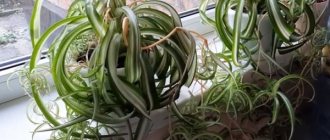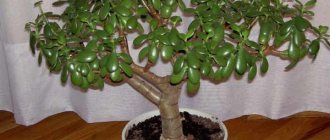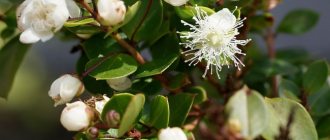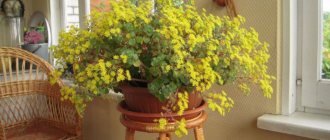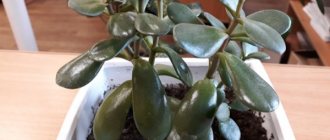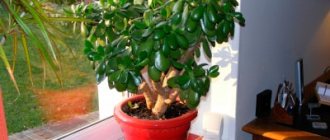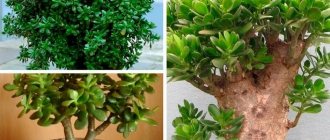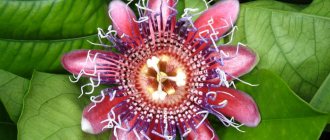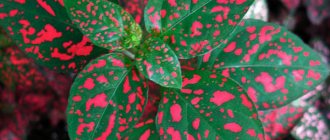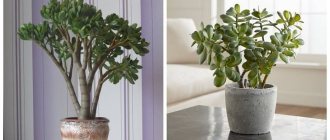The succulent plant Crassula or Crassula belongs to the Crassula family. The flower got its name from its fleshy leaves, since the word “crassus” means “thick”. In nature, representatives of this species are found on the Arabian Peninsula, Madagascar, and South Africa. Many species are grown at home. Flower growers call the Crassula “money tree”, which is associated with many signs and superstitions. In our article you can study the names, types and photos of Crassula, features of caring for the plant and signs of the money tree.
Crassula - types, photos and names
Both in nature and in indoor floriculture, crassulas are found in the form of tree-like shrubs and herbaceous plants. These can be very small succulents or large trees. But all plants have one common feature - fleshy leaves that grow opposite each other on the stem.
At home, Crassula does not have the same large size as in nature, since it grows in a small amount of soil, is limited in space and does not have many other conditions that in nature contribute to intensive plant growth. But even a homemade crassula or money tree from a small shoot or leaf will eventually grow into a tree with a thick trunk.
Crassula leaves, depending on the type, can be entire, simple or ciliated. Under good conditions and proper care, racemes or umbellate-paniculate lateral inflorescences consisting of red, bluish, yellow or white flowers are formed on the Crassula.
Description of Crassula (Crassula)
The genus Crassula is quite numerous and is distinguished by a variety of species. Most of them belong to the succulents of the Crassulaceae family, of which there are more than 350 species in nature. They grow in the driest places on our planet. The more complex the living conditions, the more bizarre their appearance, the more interesting their coloring and the more unusual the flowers. Crassula grows in Madagascar and in the south of the Arabian Peninsula. Most of the Crassulas are in South Africa. Translated from Latin, “Crassula” means “thick”. The leaves of Crassula live up to the name of the flower - they are fleshy and thick. In terms of external characteristics, different types and varieties of Crassula are very different from each other. Among them there are very tiny plants, but there are also giant trees, up to several meters in height. But all species have similarities - this is the opposite arrangement of leaves on the stem and the absence of dissection of the leaf blades. Moreover, each pair of leaves is located at right angles to the previous pair. Crassula flowers of different colors are usually small in size and collected in inflorescences. The number of stamens and the number of petals are the same.
All Crassula species contain arsenic in the juice of the leaves. Eating leaves is dangerous to life!
Many species of Crassula live well in our apartments, but some are cultivated only in greenhouses. The most common Crassula species in indoor floriculture can be divided into three groups: tree-like, creeping (groundcover) and spicate (columnar). Let's consider each type in order.
Types of Crassula - photos, names
There are a large number of types of Crassula, of which we will describe the most popular and in demand for growing at home.
Crassula tree - photo
Crassula of this species is a large plant with a thick, bare trunk and branches on which flat, obovate, round leaves grow. The leaves are three to seven centimeters long and have a light gray color, a bluish tint and red edges. Crassula tree rarely blooms at home. In nature, it produces panicles with white or pale pink flowers.
This type of Crassula loves bright light and does not tolerate shadows at all. With good care, even at home, the tree can grow up to one and a half meters in height. The following varieties of Crassula tree are known:
- curly - the plant got its name because of the wavy large leaves;
- Undulatifolia is a type of Crassula with silver-blue or variegated flat, narrow leaves.
Crassula ovata - photo
This is an ovoid or oval Crassula, which is most often found at home. In nature, the shrub reaches a height of three meters. In an apartment, a tree can grow up to one and a half meters in height. It has a large number of fast-growing shoots with green or silver-gray oval, shiny leaves. Crassula ovata blooms with pink or white flowers, which are collected in umbrella-shaped apical inflorescences.
You will be interested to know: Can Decembrist be kept at home? The meaning of the Decembrist in Feng Shui, signs and superstitions
This species is easy to care for and shade-tolerant. The most famous varieties of the ovata money tree are:
- Crassula Sunset is a plant with beautifully colored leaves, which are distinguished by a bright red border and yellow or white stripes along the edge. This type of Crassula requires good lighting, otherwise the foliage will turn a plain green color.
- Crassula Goluma is an American hybrid variety that is distinguished by its leaves rolled into a tube. The leaves expand funnel-shaped towards the base.
- Crassula Tricolor - from the name of the flower you can understand that its leaves are tricolor. They have red edges and white stripes in the middle on a green background.
- Crassula Hobbit is a hybrid with leaves turned outward, which are fused from the base to the middle.
- Crassula Minor is a compact plant suitable for a mini-garden with leaves no more than one centimeter wide and up to one and a half centimeters long.
Crassula moss - photo
A ground cover plant up to 25 cm high has creeping tetrahedral shoots. The species got its name because it looks like a moss.
Crassula moss is distinguished by small, scale-like leaves that fit tightly to the shoot and are folded in four rows. In intense light, the leaves take on a reddish tint.
Crassula perforata or perforatum - photo
Columnar-shaped fatty plant with diamond-shaped leaves, which seem to be strung on shoots. The leaves have a light green color, a bluish tint and a gristly red border.
Crassula Spring Time - photo
The hybrid form of the Crassula is distinguished by a compact ground part, shoots prone to lodging, bright green, succulent foliage and light lilac flowers.
Crassula rupestris
A herbaceous plant with erect or creeping shoots that can reach 60 cm in length. Its ovoid small leaves, smooth and reddish along the edges, are 1-2 cm wide and 1-2.5 cm long. Umbrella-shaped inflorescences are formed in the upper part of the shoot with yellow flowers.
In addition to those described above, there are also quite a large number of species of domestic crassulas, which differ in the shape, size and color of the leaves, as well as the size and shape of the plant itself.
Decorative flowering
A group of fat plants that can bloom when kept indoors. They are distinguished by more complex care and a very decorative appearance. The most famous crassulas of this direction.
Crassula crescent
A small tree growing up to 1 m in height. The leaves are large and fleshy. They have a characteristic sickle shape, slightly blunt ends. Growing together, they clasp the stem, after which they actively grow at a right angle. Flowering occurs every year, usually in the second half of summer. Large umbrella-shaped inflorescences in some varieties are formed up to 20 cm in diameter. The color of the flowers is usually red.
Crassula Schmidt
This is a compact and very decorative shrub; at home it grows up to 20 cm in height. The leaves are lanceolate, narrow and very sharp at the end. This variety of Crassula is distinguished by the attractive color of the leaf blade - it is green on top with a slight silvery tint, and covered with a red coating on the bottom. Flowering is annual and very long, the dark red flowers are small, outwardly reminiscent of carnation inflorescences.
Crassula pierced leaf
A profusely flowering shrub that can grow up to 1 meter in height. The long, fleshy leaves are pointed, triangular-lanceolate in shape (see photo). Umbrella inflorescences are collected from several dozen small flowers, white or red. Flowering is observed only in summer; in winter the plant goes into a dormant stage.
Crassula Justi-corderoi
Externally, this variety is very similar to Schmidt's Crassula. It differs in the appearance of its leaves, which are slightly rounded and covered with small cilia. Flowering occurs in the second half of summer, the inflorescences are small, some varieties have single flowers. The petals are usually red.
Crassula flower: home care
It is best to place a money tree or crassula on an eastern or southwestern window sill. Some types of Crassula can easily tolerate even direct sunlight. But from a lack of light, a plant can lose its decorative effect. Its leaves turn pale and fall off, the shoots stretch out and the bush becomes ugly.
In the warm season, a tree or herbaceous plant can be placed in the garden or on an open balcony. In winter, you don’t have to worry that a flower pot at home is standing next to working batteries. Crassulas can easily tolerate dry air and heat. If the room is cool, then the air temperature should be at least +10 degrees.
Crassula diseases
Bacterial burn. Its main manifestation is red spots on the leaves.
Diseased leaves need to be removed, plants should be sprayed 2-3 times with Fitosporin-M (3) with an interval of 10 days.
Yellowness of leaves. It causes the leaves to gradually change color to yellow.
Treatment consists of removing the affected shoots.
Mosaic epiphyllum. It destroys plant tissues - transparent, blurry yellow spots appear on them.
Treatment is impossible, the plant is destroyed.
Fusarium. First it affects the roots, then penetrates the stems and leaves. Crassula stops growing, the leaves turn pale and become lethargic, and a rusty tint is visible on the cut.
Diseased areas are cut out, sprayed with Fitosporin-M solution (3), dried, and replanted in fresh soil.
Anthracnose (brown spot). Appears in the form of round light or brown spots on leaf plates.
At the initial stage, diseased parts of the plant are cut out, and the sections are sprinkled with charcoal. Then spray 2 - 3 times with a solution of Fitosporin-M (3) with an interval of 10 days.
How to care for Crassula?
All succulent plants, including Crassula plants, are unpretentious in care. You only need to follow a few simple rules:
- Watering should be regular, but not frequent. In warm rooms, water the soil only when its top layer is thoroughly dry. If the plant is kept in cool conditions in winter, then it should be watered only when the soil dries to a depth of two to three centimeters. Crassulas are plants that are better underwatered than overwatered. Therefore, you should not get carried away with watering the money tree, which can react to constantly damp soil by dropping leaves and rotting the trunk.
- Crassulas only need feeding Fertilizers are used for cacti and succulents. There is no need to feed the money tree in autumn and winter.
- to spray the plant, since all succulents tolerate dry air well. However, in order for the leaves to have a decorative appearance, it is recommended to wash them periodically. You can do this under a warm shower, having first wrapped the pot in cellophane so that water does not fall on the ground.
You will be interested to know: Signs of the Spathiphyllum flower Women's happiness and features of caring for it
LiveInternetLiveInternet
Crassula arborescens
I have already shown you my krassulki
here.
Now you can boast about their “children”))) What can you say about it (Crassula)???
It seems to me that there is absolutely nothing new that is not on the Internet. I’ll write about how to care for her a little lower, but now a couple of photos of my “new ones.” True, for me they are not new at all, but I didn’t brag to you, so it will be new for everyone))) Photos of the new Crassulas
From left to right: Tree-like, Hobbit, Tree-like, rupestris. The outermost pot on the right (white) is an aichrizon, not a Crassula, but also from the succulent family. Now let’s talk about each one separately))) This tree has been growing for me for about a year now. There are two sprouts in one pot. When he was circumcised, his “mother” decided to keep these very shoots for herself.
During this time it has more than doubled. And what’s most interesting is that I never fertilize Crassulas with anything. They grow with me, as they say, on a starvation diet. The only fertilizer is replanting. Maybe if I fertilized as expected, they would grow bigger))) but for now I appreciate their decorative appearance)) BUT!!! I already bought fertilizer for the summer)))) And this is a baby from Crassula, which I bought and shaped especially for my husband as a gift. This beauty has already grown))) It’s already taller than the previous bush. This one has small and not so fleshy leaves, and the stem itself has a burgundy tint and half of the leaves on the back side are also burgundy))). As I understand it, this is a completely different variety/variety of tree crassula
Crassula Hobbit
Crassula Hobbit, a common cultivar of the oval Crassula, which is more compact than the parent natural species. It grows slowly and itself, without human intervention, forms a knotted stem of an interesting bonsai shape. It has unstable leaf shapes that are most often open at the bottom, along with some club-shaped leaves. Interesting with the rich burgundy shade of the reverse side of the sheet. Blooms with pinkish-white star flowers in winter Here is my entire beauty.
For comparison, I’ll show you what it was like last year (growth dynamics) on January 6, 2014.
And these are its leaves closer. I love these “Shrek ears”))))
In one year she grew twice as tall)))) Therefore, from personal experience I say that she is growing quite quickly.
I also want to pay a little attention to such Crassulas as Gollum and Coral. Crassula Gollum, Coral, Hobbit are often confused with each other and their distinctive features are not distinguished as characteristics of the variety... But they are really different! Both according to the leaves and according to the constitution. Here is
Crassula
Coral . It mostly has stick-like leaves, tapering towards the end and, for the most part, having funnel-shaped tips, as well as a powerful trunk and numerous side
shoots
Crassula Gollum . It mostly has leaves like “Shrek ears” - tubular, funnel-shaped, with cup-shaped flaring tips. It grows as a slimmer tree compared to Coral: And here is another photo, with a clear example of their difference:
And these are my two trees in one frame))
We seem to have sorted this out)))) Let’s move on to the next item on our “menu”
Crassula rupestris
Crassula rupestris is a bushy plant with vertical or lodging stems, highly branched, up to 50 cm high. Some sources write that in late autumn - early winter numerous star-shaped flowers with a diameter of about 6 mm, with a pleasant smell, pink or white, collected in apical inflorescences growing from the axils of the apical leaves. And some write that in May-June. It hasn’t bloomed at home yet, but at work every winter it showed off white flowers. Sorry I didn't take a photo. Botanist Vera Higgins gives descriptions of the most common forms: 1. Leaves are lanceolate, rather large, bluish, with convex lower and upper sides. The flowers are white. 2. Leaves are ovate, green or slightly bluish with dots and a red stripe on the upper side. The flowers are pink. This form is typical of the Karoo Desert. 3. Leaves, like the previous form, but smaller in size. In culture it is often found under the incorrect name Crassula brevifolia Haw. Care: an unpretentious plant that is grown in a sandy, well-drained substrate in bright light. During the growth period - moderate watering, during the dormant period, immediately after flowering - dry content. Minimum temperature 5C. It is recommended to avoid drafts. Reproduction: by leaf or stem cuttings, which are rooted in a sandy substrate. I propagated it with twigs. I tore off (not even cut) a twig, shoved it into the soil and that’s it! No roots, no bottles. Everything is easy and simple)) Here is mine after transplanting into a separate pot
Recommendations for care
I write the same care recommendations for all my fatties, since I have the same care for all)))
Watering
From April to September, water once a week; in December - January, do not water at all; the rest of the time between these two periods, once every three weeks. In spring and summer, the soil should be only slightly moist before the next watering; in autumn and winter, it should be almost dry. It is important to remember that excess moisture is more dangerous for Crassula than its lack, especially in winter. Excess moisture makes Crassula very vulnerable to fungal diseases, as a result of which the leaves turn yellow, then darken and fall off. In this case, the Crassula must be removed from the pot, the earthen ball dried and the root system treated with special preparations.
Lighting
The plant should be placed in a bright place with shade from direct sunlight. In the summer, they can be placed on the balcony or in the garden, being sure to protect them from the sun and rain. In the autumn-winter period, a place with the brightest light is provided for the plant - this is extremely important, since a lack of light can lead to leaf fall and death of the plant.
Top dressing
It is recommended to feed Crassula from April to September, approximately once a month with a solution of universal fertilizer or special fertilizer for cacti and other succulents. The rest of the time, the plant is also fed once a month, but with a fertilizer solution of half concentration. Fertilizer is applied only to moist soil immediately after watering.
Transfer
Adult plants are replanted every two years. Crassula grows quite slowly, gradually increasing in length and width. It is recommended to replant in the spring into soil for succulents with good drainage.
Possible difficulties
The main danger for Crassula is excess moisture, which leads to rotting of the root system and base of the trunk. The plant also does not tolerate drafts, as it causes its leaves to dry out and fall off. The mealybug is removed with a cotton swab soaked in pure alcohol, or the plant is treated with systemic insecticides for succulents.
Aichrizon
Aichrizon, or as it is popularly called the Tree of Love, is a small shrub with a diameter of 20 - 30 cm, reaching a height of 30 cm. The plant Aichrizon belongs to the Crassula family and grows in nature in rock cracks.
A distinctive feature of Aichrizon is the appearance and shape of its leaves - fleshy, dark green, covered with fluff, with short white hairs, they seem to be in a fur coat))))
Due to the unusual shape of the leaves, reminiscent of hearts, two beautiful popular names were attached to it - “Tree of Love” and “Tree of Happiness”. The straight or slightly curved fleshy stems of Aichrizon practically do not become lignified and branch very strongly even without pinching operations. It blooms with proper care, mainly in April or May, the flowers themselves are small and star-shaped in red, yellow or cream color. I have yellow ones)) At the end of the flowering period, the rosette that produced the peduncle dies. This is how my tree bloomed!
Unfortunately, I don’t have a close-up photo of the flower itself, somehow I didn’t think of taking a photo of it at that time))) Not everyone can observe the flowering, since there are a number of rules that must be strictly followed if you want to achieve the desired result - flowering: 1. The pot should not be large, solely in terms of the size of the roots;
2. Cool and light wintering; 3. Not frequent watering, but I also don’t recommend drying the flower, as the leaves will become lethargic and begin to fall off; 4. It should be noted that during the flowering period, the aichrizon plant loses up to 70% of its leaves, so it is necessary to remove peduncles and weak shoots and increase watering;5. The tree loves bright diffused light, so no direct sunlight; 6. In the spring-summer period, the preferred air temperature for Aichrizon is around 20-25°C. In autumn and winter, it is necessary to keep the aichrizon at a temperature of +8-10°C. When kept in a room with a higher temperature (+15-22°C), the shoots become elongated and the leaves begin to fall off. Aichrizon should not be placed near heating appliances. 7. Humidity, in principle, does not play a significant role, since Aichrizon tolerates dry indoor air well. A useful procedure is periodic bathing in a warm shower. Only during the dormant period (autumn and winter months) such a process is contraindicated for the plant. 8. In spring and summer, Aichrizon is fed every two weeks. I use a complete fertilizer for succulents that is low in nitrogen. 9. The need for a spring transplant of Aichrizon is determined as the pot is filled with roots. Due to the shallow root system of the plant, I recommend using shallow containers or flowerpots. My pot is tall, so I filled half of it with expanded clay. I planted it in special soil for cacti. In general, a substrate of sand and turf soil is recommended, or a mixture of turf, leaf and humus soil with sand in a ratio of 4:1:1:1. Useful additions include pieces of coal or brick chips. The bottom of the pot requires good drainage. The first watering is usually carried out 4-5 days after transplantation: very
carefully, in small portions, in order to prevent rotting of the root system. Clay pots are best suited for growing because they provide high porosity and breathability. I, in turn, failed to follow all the rules in watering and almost destroyed my tree. The leaves began to brown, wrinkle and fall off. The root system was completely destroyed by me. There was even rot on the stem. I managed to chop two healthy branches from my tree and set them to root. There were no changes for a long time, but they were in no hurry to die. Here he is my sufferer.
Top view.
Now I look after him like a little child, so as not to repeat my mistake.
That's all for today. See you soon.
How to transplant a fat plant correctly
Crassula is transplanted into a new pot as needed. To do this, you need to take a container two centimeters larger than the previous one, the bottom of which is filled with drainage and soil for succulents. After this, the plant is carefully removed from the old pot. It must be taken so as not to damage the shoots and break off the leaves. Together with a lump of earth, the bush is placed in a prepared pot, its roots are covered with soil and watered.
Attention! Do not choose large pots for the fat plant! Its roots in such a container will grow deep and its stems will grow upward. As a result, the bush will stretch out and be ugly.
To maintain the compact size of the plant, it does not need to be replanted at all. It will be enough for the fat woman if every spring the top layer of soil is replaced with new nutritious soil.
Pests and diseases of Crassula
The following pests can cause harm to Crassula at home:
- Spider mites appear on the plant in dry air and if the tree has not been watered for a long time. You can find out about its appearance by the cobwebs on the leaves. The pest is destroyed by treatment with insecticidal preparations.
- Scale appears in the form of brown plaques. You can get rid of it with the help of Actellik.
- Mealybugs look like pieces of cotton wool that can be seen on leaves or shoots. It is removed from the plant using a cotton swab soaked in alcohol.
All pests feed on plant sap, as a result of which the leaves first turn yellow, dry out and fall off, and over time the flower itself dies. Therefore, when they appear, it is necessary to immediately treat them with insecticidal preparations.
The money tree is disease-resistant, but drafts, cold air and excess moisture in the soil can lead to rotting of the roots. As a result, the base of the trunk will begin to rot and the plant will die. It will be possible to save it only if you cut it off and plant more whole shoots.
Propagation of Crassula by cuttings
The easiest and fastest way to propagate Crassula is by cuttings, which can be used as shoots and leaves. Reproduction is carried out as follows:
- A large leaf or large shoot is cut off with a sharp knife.
- The cut is processed with crushed coal.
- The leaf or shoot is dried at room temperature for two or three days.
- The cuttings are planted in a mixture of leaf soil and sand or in soil for cacti.
- The shoot can first be placed in a solution of water and charcoal, and when it gives roots, transplanted into a small pot.
You will be interested to know: Is it possible to keep a monstera at home?
It is better to use shallow containers for planting leaves. The shoots are planted in pots with diameters up to 5-7 cm. Caring for them consists of moistening the soil, which is not recommended to be watered too often. The leaves can simply be sprayed with water from a spray bottle occasionally.
Propagation of Crassula by cuttings
The easiest and most productive way to propagate crassula is by cuttings. For this species, not only leaves, but also shoots can be used as planting material. These may simply be fallen parts of the flower. Before planting the seedling in the ground, it is recommended to treat the cut area or wound with charcoal powder. Some gardeners also advise “withering” part of the plant for 2-3 days.
Crassula reproduction
Due to the fact that the flower is absolutely unpretentious, the seedling can be rooted in different ways:
- after short drying;
- after rooting it in a glass of water;
- without preliminary preparation, plant directly into the ground.
Note! If, before planting, preliminary preparation of the seedling is carried out, then you should wait until the first roots appear.
Money tree in the house: signs and superstitions
It is believed that the fat woman brings prosperity to homes and helps in business. Therefore, this tree can be seen not only in apartments, but also in offices. According to folk superstitions, a money tree will bring prosperity and prosperity to your home under the following conditions:
- The owner of the apartment himself grew the plant from a seed or shoot.
- Crassula will show its best energy abilities in the southeastern part of the apartment.
- Dust that interferes with financial flows must be regularly washed off the leaves of the plant.
- The fat woman needs to talk about her financial problems. If they are resolved, then thank you for your help.
- It is not recommended to place a money tree next to radios, mobile phones, and televisions. They take all the energy from the plant.
- Since money loves to count, when washing a bush you need to count the leaves on the fat one.
- From each amount earned, you should allocate a metal coin, which should lie next to the flower.
- To feed the money tree with additional financial energy, it is recommended to plant it in a red pot or simply tie it with a red ribbon.
- Another sign that will attract financial well-being to the house is tying banknotes between the leaves of the fat plant, which should be renewed periodically.
It is not recommended to give a crassula or even its shoot as a gift. As a last resort, the one to whom the money tree is given must give a coin in return. But you can give Crassula for a wedding. This gift is accompanied by banknotes tied with a red ribbon.
All these signs and superstitions about the money tree have not been scientifically proven. But it is known for sure that the fat man has beneficial properties. The plant releases substances into the air that have antifungal, antiviral and antibacterial effects.
Crassula leaves have medicinal properties and are used for rubbing for arthritis, for the treatment of stomatitis and sore throat, as a lotion for abscesses, cuts, insect bites for the treatment of herpes. However, the leaves of the fat plant contain arsenic, so they should not be taken orally!
Crassula Marnier – jade bead
Among the various Crasulaceae, Crassula Marnier is a particularly unique plant.
From a distance, it looks like thick worms sticking out of the ground like little soldiers, or trying to crawl in different directions. Taking a closer look, it becomes clear that the succulent consists of individual leaf fragments, as if strung on a thread, and each of them looks like a miniature roof of a Chinese temple with the edges turned outward. In English-language botanical literature, the plant has quite official names: Jade Necklace - jade necklace and Chinese Pagoda - Chinese pagoda. Folk names are also common: children's necklace and worm plant.
The homeland of this amazing baby is South Africa, Swaziland and Lesotho. The plant received its specific name in honor of the French botanist-researcher Julien Marnier-Lapostollet, the son of a famous winemaker and creator of the famous citrus liqueur Grand Marnier based on cognac.

